a wandering minstrel I
Almost precisely a year after my trip to China, here are some of my photos from Beijing. This year I'm due to return to China again, or more specifically Tibet by way of Nepal. My trip is payed for, the plane ticket has been bought, visas will be secured upon my arrival. Time to start thinking of packing and pills, shoes and boots and weather conditions, altitude sickness and alarm clocks.
Outside the rain pours down as the rainy season continues. Tanabata approaches, but will I even be able to see the stars?
8月2日06年
It's hard to know where to start writing, today. My shoulders ache with the tension of a very, very long and full day, which is at last at an end. Well, my obsession with this pseudo-historic drama is delaying said ending, but it's close enough.
Staring through the window of the taxi this morning, I saw the massive facades of skyscrapers and broad, crowded streets. Tianamen Square passed in a blur of flat cobblestones and shifting crowds, and I feared that my trip to China would end on a soulless, disappointing note.
The Square, where we started the day, certainly reinforced that impression. Lonely Planet characterizes it as a desert, which seemed fair to me. A desert where the shifting sands are wandering people, bounded on all sides by mountainous, ugly soviet-inspired buildings. They're grand, certainly, but aggressively unlovely. Tianamen itself, the Gate of Heavenly Peace, is a bit better, but far too big to connect with-- part of the point, I guess. Perhaps a similar thought process went into the Communist-built government buildings, but I don't understand why creating something "for the people" necessitates ugliness. Communist art is massive, blocky, and unpleasant. In Budapest, I recall, they banished it all to a windswept and barren park miles outside the city itself.
Mao's portrait doesn't really improve things. Say what you will of the personality and the deeds; the fact remains that he was not a pretty man.
Through the gate to the north, and then through a few more after that, you reach the Forbidden City. All the buildings are likewise on a massive scale (although I don't think historic excesses can excuse more modern ones), but the City boasts elaborate painting and ornamentation that makes the huge buildings beautiful rather than brutal. Wandering through the successive courtyards, while at times overwhelming, affords fantastic views and moments of rare beauty.
I can't remember the last time I saw so many people, though. Huge crowds everywhere in the complex. Getting a glimpse inside any of the buildings was worth your life-- frantic, determinedly pushing Chinese tourists crammed every window and doorway. A glimpse of an interior demanded equal aggression and a certain mercenary willingness to employ elbows and take advantage of any available opening.
The garden in the back was more to my liking. It, too, teemed with visitors, but it was smaller, friendlier, more intimate. And there's only so much the clangor of human voices can do against the silence of trees and rocks.
Photojournalism: Tianamen Square
One of my first easily identifiable views of Beijing, from the taxi.

One of the People's buildings, I don't recall which one (everything's The People's; this is Beijing, after all), with the Olympic countdown clock.

Tianamen Square was filled with people, and the line for Mao's mausoleum already stretched all the way across it. Apparently there are a whole lot of people eager to see pickled Mao. I was more excited by the kite. Wish I'd gotten to see it fly . . .
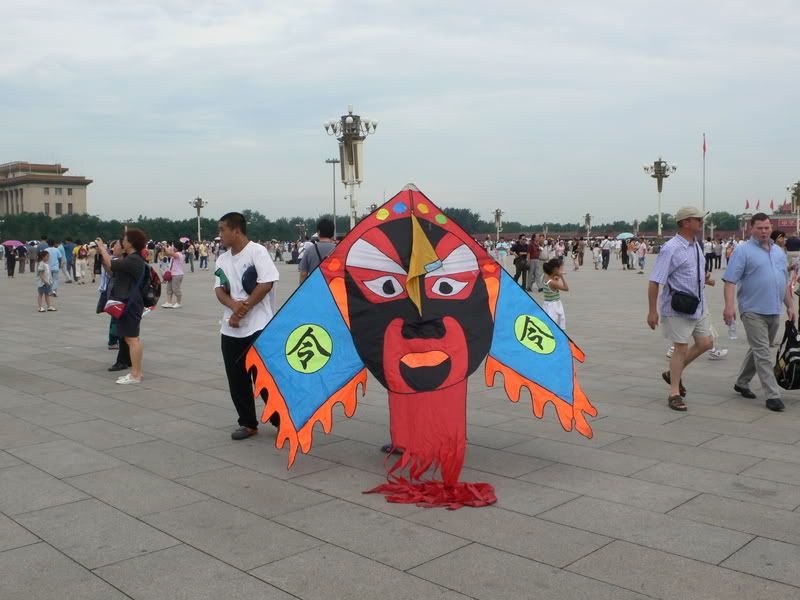
The famous Tianamen Gate, outer bastion of the Forbidden City.


More Tianamen Square buildings. It's probable that their names contain the words "the People's" or "Of the People" or "Mao's" somewhere.


The ubiquitous army officers. There were certainly a lot of them, marching around in step and looking official.


8月3日06年
Unfortunately for me, we didn't spend much time there. The problem with traveling with a group is that you must adhere to the group's schedule; if the group moves on, you have to do the same.
The huge size of the Forbidden City, combined with the hammering sunlight in the courtyards, left me feeling drained and exhausted. But our trip through the hutongs revived me. We started on foot through the narrow alleyways that suddenly materialized on the northern side of the Forbidden City. One moment we walked along wall, the next we had turned into an unmarked side street that snaked carelessly back and forth. The walls of the various hutongs continuously lined its roughly-paved length, broken here and there by gates or intersecting streets. We learned later to pay attention to the gates as indicative of the status of those who once owned it. More steps meant higher rank or importance. Nine was reserved for the Emperor, eight or seven for those related to the royal family, and so on down the line to the two or three steps for common craftsmen and artisans. Flanking statues of drums on either side of the gate indicated a military officer, since drums were used to convey messages and give orders. Furthermore, the size and grandeur of the gate itself showed the wealth and social standing of the family who lived there. A good marriage was between two families with door lintels of the same height-- that is, between two families of equal status, neither of them higher or lower than the other.
So much history and meaning in the gateways alone! That same sense of ancient grandeur hung like an aura over the now-crumbling hutongs. Now many of them are home to those too poor to live elsewhere. Their very age means that they lack many modern conveniences-- interior bathrooms, reliable electricity, effective heating and air conditioning. But there was something lovely about the brick walls and the courtyard-facing houses they contained. No structure was higher than two stories, lending them a comforting closeness. Here and there tall, shady trees hung their heavy branches over the walls, providing leafy beauty and welcome shade.
We passed through the pleasant maze of some of the hutongs twice, on foot and by bicycle rickshaw. The later was particularly pleasant as it afforded us a pleasant breeze and some time off our complaining feet. I wandered through on my own, later, again on foot, and found myself treading the bar-and-shop-lined streets surrounding a pleasantly flowing pond. In the mid afternoon they were, while not particularly quiet, at least somewhat restrained and pleasant in their bustle. I settled on a low marble bench with my bottle of jasmine tea to watch the various boats glide through the water and admire the blooming lotus flowers and draping willows. The first swimmer I saw bobbing in the water astonished me, but they quickly proved themselves as common as the boats.
Today we took a bus for several hours with the express purpose of walking a section of the Great Wall. And walk it we did, or perhaps climb it, as the way was often steep. Parts of it were restored and in good repair, other parts were crumbling-- but the grandeur and vastness of it was apparent everywhere. It ran an impossible river up and down the jagged backs of the cliffs, like a proud, upright crest. In most places it was as broad and open as a road.
Crenelations and braces for crossbows hugged one side of the wall, a constant reminder of which direction was north; Mongolia, in other words. Unknown lands. To the south, China, known lands. Well, as known as nearly three weeks' travel will allow.
The scenery was breathtaking. Mountains and unexpected pockets of valley stretched away on either side, blanketed in greenery.
Photojournalism: the Forbidden City
Even after passing under Tianamen Gate you still have several even more imposing structures to go before you reach the main part of the Forbidden City. It's hard to help being awed.


The gate through which we entered the lovely interior courtyard with its graceful canal and bridges.

The canal itself. I'm very proud of this picture.

More views of the buildings in that courtyard.


Looking back at the bridges.

One of the buildings from that first courtyard.

A detail from the fantasticly elaborate painting that decorated the eaves of all the buildings.

Alas, the main building in this courtyard was being restored in preparation for the Olympics. I'll just have to come back some day and take a more leisurely tour through the City.

Even the gables were elaborate.

The next courtyard along contained a pyramid of pedestals. Because the central building is on a series of pedestals, and then inside that building the throne is on a series of pedestrals.

Detail from the caved porches.

A throne! Of which there were several, gradually increasing in prominence.

The next courtyard . . .

. . . and another throne!

The view across the courtyard.

Details of the buildings and the roofs of the Forbidden City rising all around.




The ramp descending into the main courtyard. Each carved panel was made of a single piece of stone, and only the Emperor could walk there.



The railings were carved with dragon and phoenix motifs.

Views of the courtyard.


More aesthetic details.

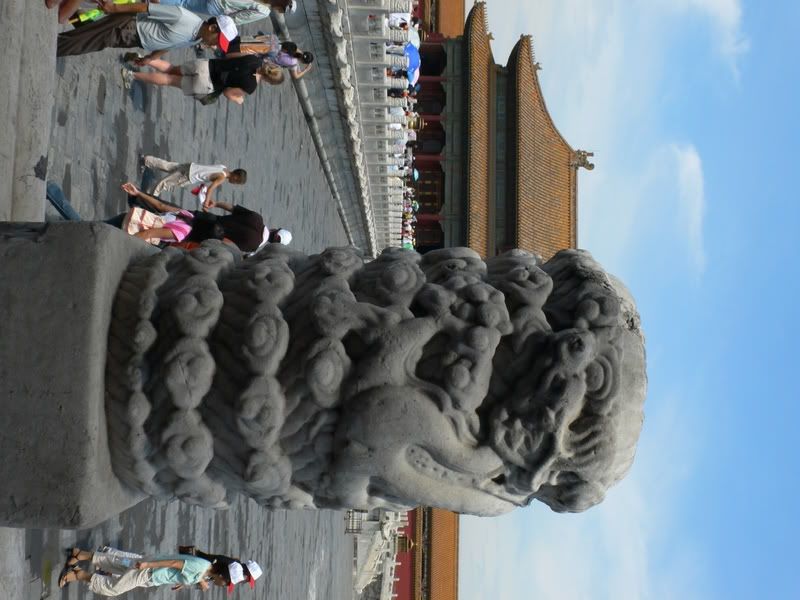

And again, a throne!


A sundial on the porch outside.

Heading towards the rear gardens, a famous intertwined pine tree, many hundreds of years old.

Detail from the wall.

Lovely, shady trees.

Quiet views from within the gardens. A lotus-pond.
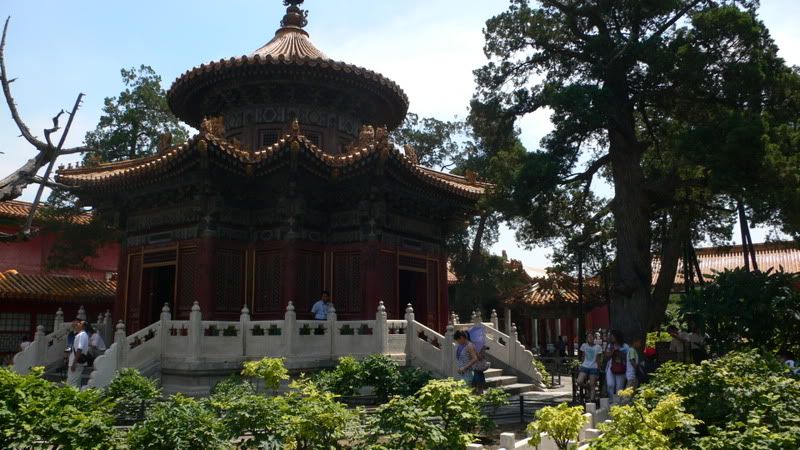

There's a fascination with strange rock formations in Chinese culture that I don't really understand. Are they symbolic? Objects for meditation? Or just fun to look at? I know that some people collect them and they can be really, really expensive.



A detail from one of the stone-carved bases.

Blissful shade.
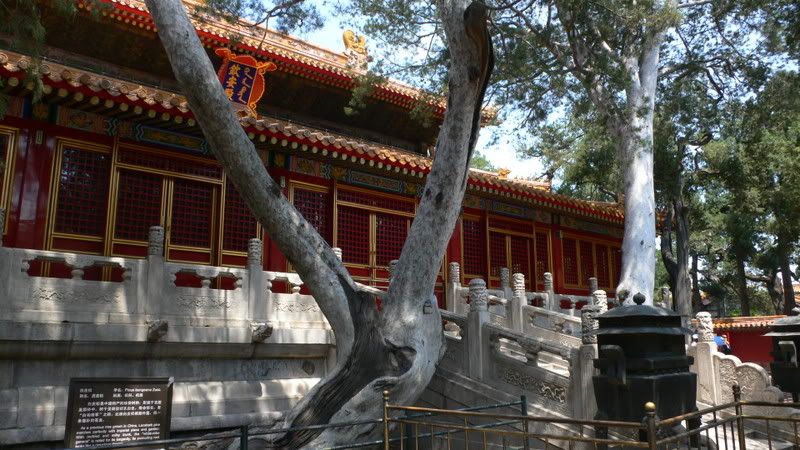
Two carved stone dragons cavorting through the clouds.



The back gate . . .

Heading out the back gate of the Forbidden City . . .

Photojournalism: Beijing hutongs
I loved the hutongs, with their narrow, winding streets, their crumbling bricks, and the undeniable sense of life about them-- the necessities of here-and-now layered over an ancient history. We were walking down a main street, cars rushing past, and we turned abruptly down an alley . . . and there we were.
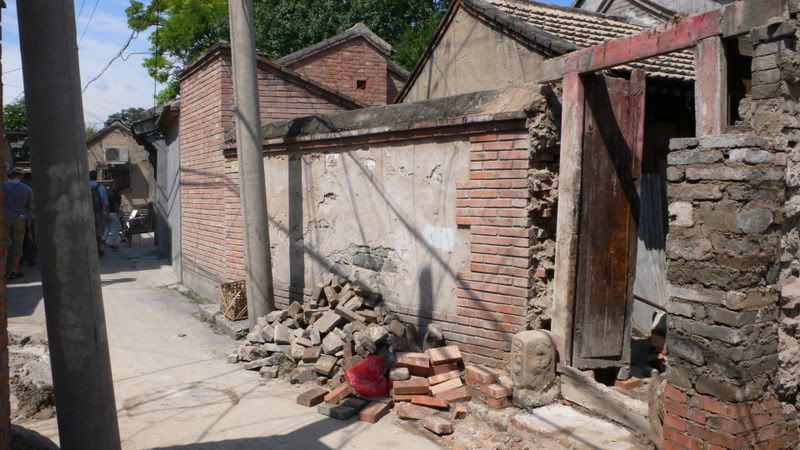

The all-important gates to the inner courtyards.

Pictures taken from the bicycle rickshaw, which was a tremendously fun and relaxing experience.


The gate to the hutong.

The wall inside the gate.

Inside the courtyard of one of the hutongs.




The drum tower, which contains the steepest steps I have ever experienced.

The water clock inside the drum tower. Still accurate, too.

The drums.

A view of the hutongs from the drum tower, and a flock of birds circling over the rooftops. The prevalence of trees in the hutongs was wonderful and cooled things down a great deal.


A view of the drum tower from . . .

. . . the bell tower. I didn't take as many pictures here, although the inside was quite interesting. Not for its bells, but for the furniture displays.

Wandering on my own through the hutongs . . .
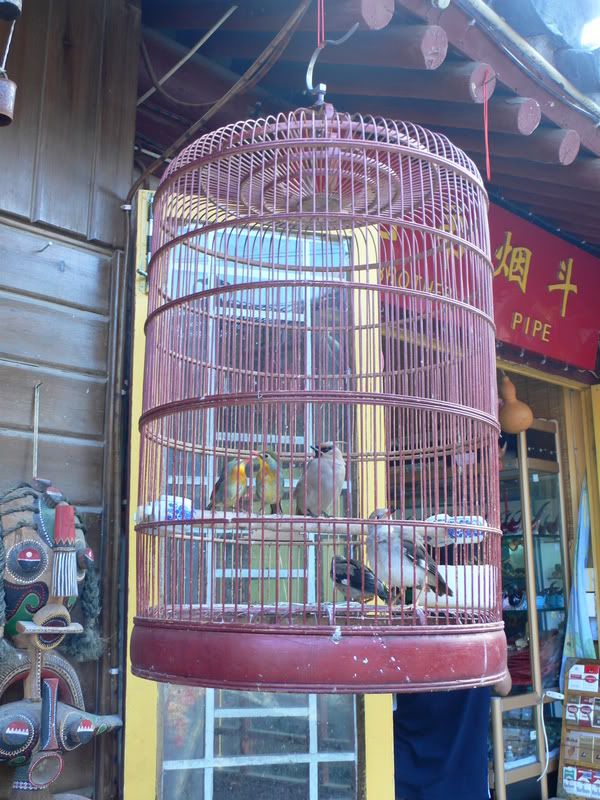
I stopped to rest by this pond, and what did I see? How strange . . .

More wandering through the hutongs.


Outside the rain pours down as the rainy season continues. Tanabata approaches, but will I even be able to see the stars?
8月2日06年
It's hard to know where to start writing, today. My shoulders ache with the tension of a very, very long and full day, which is at last at an end. Well, my obsession with this pseudo-historic drama is delaying said ending, but it's close enough.
Staring through the window of the taxi this morning, I saw the massive facades of skyscrapers and broad, crowded streets. Tianamen Square passed in a blur of flat cobblestones and shifting crowds, and I feared that my trip to China would end on a soulless, disappointing note.
The Square, where we started the day, certainly reinforced that impression. Lonely Planet characterizes it as a desert, which seemed fair to me. A desert where the shifting sands are wandering people, bounded on all sides by mountainous, ugly soviet-inspired buildings. They're grand, certainly, but aggressively unlovely. Tianamen itself, the Gate of Heavenly Peace, is a bit better, but far too big to connect with-- part of the point, I guess. Perhaps a similar thought process went into the Communist-built government buildings, but I don't understand why creating something "for the people" necessitates ugliness. Communist art is massive, blocky, and unpleasant. In Budapest, I recall, they banished it all to a windswept and barren park miles outside the city itself.
Mao's portrait doesn't really improve things. Say what you will of the personality and the deeds; the fact remains that he was not a pretty man.
Through the gate to the north, and then through a few more after that, you reach the Forbidden City. All the buildings are likewise on a massive scale (although I don't think historic excesses can excuse more modern ones), but the City boasts elaborate painting and ornamentation that makes the huge buildings beautiful rather than brutal. Wandering through the successive courtyards, while at times overwhelming, affords fantastic views and moments of rare beauty.
I can't remember the last time I saw so many people, though. Huge crowds everywhere in the complex. Getting a glimpse inside any of the buildings was worth your life-- frantic, determinedly pushing Chinese tourists crammed every window and doorway. A glimpse of an interior demanded equal aggression and a certain mercenary willingness to employ elbows and take advantage of any available opening.
The garden in the back was more to my liking. It, too, teemed with visitors, but it was smaller, friendlier, more intimate. And there's only so much the clangor of human voices can do against the silence of trees and rocks.
Photojournalism: Tianamen Square
One of my first easily identifiable views of Beijing, from the taxi.

One of the People's buildings, I don't recall which one (everything's The People's; this is Beijing, after all), with the Olympic countdown clock.

Tianamen Square was filled with people, and the line for Mao's mausoleum already stretched all the way across it. Apparently there are a whole lot of people eager to see pickled Mao. I was more excited by the kite. Wish I'd gotten to see it fly . . .

The famous Tianamen Gate, outer bastion of the Forbidden City.


More Tianamen Square buildings. It's probable that their names contain the words "the People's" or "Of the People" or "Mao's" somewhere.


The ubiquitous army officers. There were certainly a lot of them, marching around in step and looking official.


8月3日06年
Unfortunately for me, we didn't spend much time there. The problem with traveling with a group is that you must adhere to the group's schedule; if the group moves on, you have to do the same.
The huge size of the Forbidden City, combined with the hammering sunlight in the courtyards, left me feeling drained and exhausted. But our trip through the hutongs revived me. We started on foot through the narrow alleyways that suddenly materialized on the northern side of the Forbidden City. One moment we walked along wall, the next we had turned into an unmarked side street that snaked carelessly back and forth. The walls of the various hutongs continuously lined its roughly-paved length, broken here and there by gates or intersecting streets. We learned later to pay attention to the gates as indicative of the status of those who once owned it. More steps meant higher rank or importance. Nine was reserved for the Emperor, eight or seven for those related to the royal family, and so on down the line to the two or three steps for common craftsmen and artisans. Flanking statues of drums on either side of the gate indicated a military officer, since drums were used to convey messages and give orders. Furthermore, the size and grandeur of the gate itself showed the wealth and social standing of the family who lived there. A good marriage was between two families with door lintels of the same height-- that is, between two families of equal status, neither of them higher or lower than the other.
So much history and meaning in the gateways alone! That same sense of ancient grandeur hung like an aura over the now-crumbling hutongs. Now many of them are home to those too poor to live elsewhere. Their very age means that they lack many modern conveniences-- interior bathrooms, reliable electricity, effective heating and air conditioning. But there was something lovely about the brick walls and the courtyard-facing houses they contained. No structure was higher than two stories, lending them a comforting closeness. Here and there tall, shady trees hung their heavy branches over the walls, providing leafy beauty and welcome shade.
We passed through the pleasant maze of some of the hutongs twice, on foot and by bicycle rickshaw. The later was particularly pleasant as it afforded us a pleasant breeze and some time off our complaining feet. I wandered through on my own, later, again on foot, and found myself treading the bar-and-shop-lined streets surrounding a pleasantly flowing pond. In the mid afternoon they were, while not particularly quiet, at least somewhat restrained and pleasant in their bustle. I settled on a low marble bench with my bottle of jasmine tea to watch the various boats glide through the water and admire the blooming lotus flowers and draping willows. The first swimmer I saw bobbing in the water astonished me, but they quickly proved themselves as common as the boats.
Today we took a bus for several hours with the express purpose of walking a section of the Great Wall. And walk it we did, or perhaps climb it, as the way was often steep. Parts of it were restored and in good repair, other parts were crumbling-- but the grandeur and vastness of it was apparent everywhere. It ran an impossible river up and down the jagged backs of the cliffs, like a proud, upright crest. In most places it was as broad and open as a road.
Crenelations and braces for crossbows hugged one side of the wall, a constant reminder of which direction was north; Mongolia, in other words. Unknown lands. To the south, China, known lands. Well, as known as nearly three weeks' travel will allow.
The scenery was breathtaking. Mountains and unexpected pockets of valley stretched away on either side, blanketed in greenery.
Photojournalism: the Forbidden City
Even after passing under Tianamen Gate you still have several even more imposing structures to go before you reach the main part of the Forbidden City. It's hard to help being awed.


The gate through which we entered the lovely interior courtyard with its graceful canal and bridges.

The canal itself. I'm very proud of this picture.

More views of the buildings in that courtyard.


Looking back at the bridges.

One of the buildings from that first courtyard.

A detail from the fantasticly elaborate painting that decorated the eaves of all the buildings.

Alas, the main building in this courtyard was being restored in preparation for the Olympics. I'll just have to come back some day and take a more leisurely tour through the City.

Even the gables were elaborate.

The next courtyard along contained a pyramid of pedestals. Because the central building is on a series of pedestals, and then inside that building the throne is on a series of pedestrals.

Detail from the caved porches.

A throne! Of which there were several, gradually increasing in prominence.

The next courtyard . . .

. . . and another throne!

The view across the courtyard.

Details of the buildings and the roofs of the Forbidden City rising all around.




The ramp descending into the main courtyard. Each carved panel was made of a single piece of stone, and only the Emperor could walk there.



The railings were carved with dragon and phoenix motifs.

Views of the courtyard.


More aesthetic details.



And again, a throne!


A sundial on the porch outside.

Heading towards the rear gardens, a famous intertwined pine tree, many hundreds of years old.

Detail from the wall.

Lovely, shady trees.

Quiet views from within the gardens. A lotus-pond.


There's a fascination with strange rock formations in Chinese culture that I don't really understand. Are they symbolic? Objects for meditation? Or just fun to look at? I know that some people collect them and they can be really, really expensive.



A detail from one of the stone-carved bases.

Blissful shade.

Two carved stone dragons cavorting through the clouds.



The back gate . . .

Heading out the back gate of the Forbidden City . . .

Photojournalism: Beijing hutongs
I loved the hutongs, with their narrow, winding streets, their crumbling bricks, and the undeniable sense of life about them-- the necessities of here-and-now layered over an ancient history. We were walking down a main street, cars rushing past, and we turned abruptly down an alley . . . and there we were.


The all-important gates to the inner courtyards.

Pictures taken from the bicycle rickshaw, which was a tremendously fun and relaxing experience.


The gate to the hutong.

The wall inside the gate.

Inside the courtyard of one of the hutongs.




The drum tower, which contains the steepest steps I have ever experienced.

The water clock inside the drum tower. Still accurate, too.

The drums.

A view of the hutongs from the drum tower, and a flock of birds circling over the rooftops. The prevalence of trees in the hutongs was wonderful and cooled things down a great deal.


A view of the drum tower from . . .

. . . the bell tower. I didn't take as many pictures here, although the inside was quite interesting. Not for its bells, but for the furniture displays.

Wandering on my own through the hutongs . . .

I stopped to rest by this pond, and what did I see? How strange . . .

More wandering through the hutongs.

